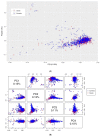A Genome-Wide Association Study Reveals a BDNF-Centered Molecular Network Associated with Alcohol Dependence and Related Clinical Measures
- PMID: 36551763
- PMCID: PMC9775455
- DOI: 10.3390/biomedicines10123007
A Genome-Wide Association Study Reveals a BDNF-Centered Molecular Network Associated with Alcohol Dependence and Related Clinical Measures
Abstract
At least 50% of factors predisposing to alcohol dependence (AD) are genetic and women affected with this disorder present with more psychiatric comorbidities, probably indicating different genetic factors involved. We aimed to run a genome-wide association study (GWAS) followed by a bioinformatic functional annotation of associated genomic regions in patients with AD and eight related clinical measures. A genome-wide significant association of rs220677 with AD (p-value = 1.33 × 10-8 calculated with the Yates-corrected χ2 test under the assumption of dominant inheritance) was discovered in female patients. Associations of AD and related clinical measures with seven other single nucleotide polymorphisms listed in previous GWASs of psychiatric and addiction traits were differently replicated in male and female patients. The bioinformatic analysis showed that regulatory elements in the eight associated linkage disequilibrium blocks define the expression of 80 protein-coding genes. Nearly 68% of these and of 120 previously published coding genes associated with alcohol phenotypes directly interact in a single network, where BDNF is the most significant hub gene. This study indicates that several genes behind the pathogenesis of AD are different in male and female patients, but implicated molecular mechanisms are functionally connected. The study also reveals a central role of BDNF in the pathogenesis of AD.
Keywords: BDNF; alcohol dependence; comorbidity; gene network; genome-wide association study; sex differences.
Conflict of interest statement
The authors declare no conflict of interest.
Figures




References
-
- Neufeld M., Bunova A., Gornyi B., Ferreira-Borges C., Gerber A., Khaltourina D., Yurasova E., Rehm J. Russia’s National Concept to Reduce Alcohol Abuse and Alcohol-Dependence in the Population 2010-2020: Which Policy Targets Have Been Achieved? Int. J. Environ. Res. Public Health. 2020;17:8270. doi: 10.3390/ijerph17218270. - DOI - PMC - PubMed
Grants and funding
LinkOut - more resources
Full Text Sources

